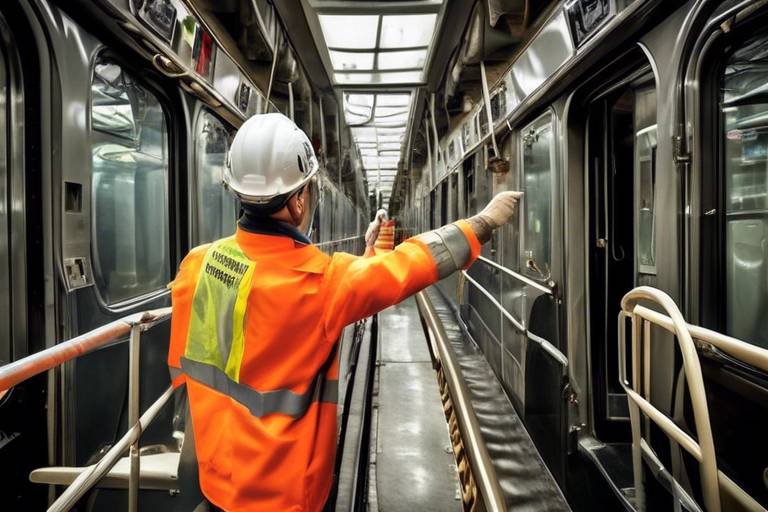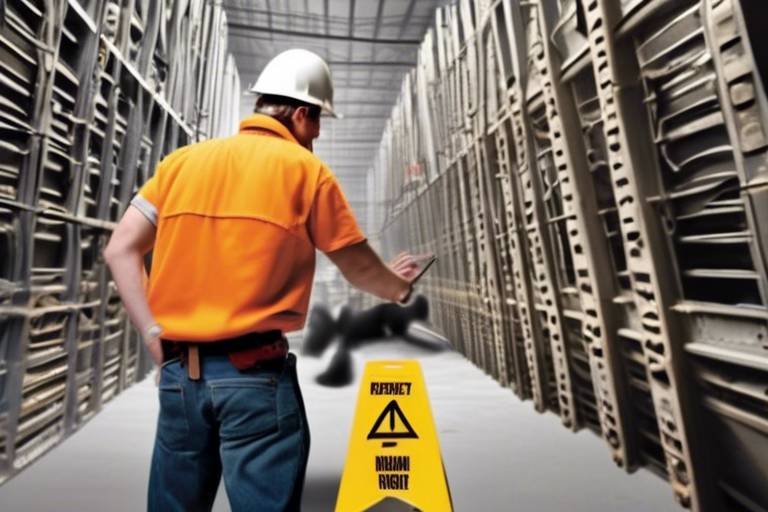The Significance of Human Behavior in Shaping Safety Policies
In today's fast-paced work environments, understanding human behavior is not just a nice-to-have; it's a necessity. Safety policies that fail to consider the nuances of how people think and act can lead to compliance issues, increased accidents, and a culture that undervalues safety. Imagine a workplace where employees feel empowered to speak up about safety concerns, where they understand the importance of following protocols, and where safety is woven into the very fabric of the organizational culture. This is achievable, but it starts with a deep dive into the psychology of human behavior.
When we talk about safety policies, we often think about rules and regulations. However, the real challenge lies in how these policies are perceived and acted upon by individuals. For instance, if employees view safety protocols as mere checkboxes to tick off rather than essential practices for their well-being, the effectiveness of those policies diminishes significantly. Understanding the motivations, biases, and psychological triggers that influence behavior can help organizations design policies that resonate with employees on a personal level.
Furthermore, safety is not solely about compliance; it's about creating a culture where safety is prioritized. This means fostering an environment where employees feel valued and heard, where their concerns about safety are taken seriously. The more an organization invests in understanding its workforce's behavior, the more effective its safety policies will be. In this article, we will explore the various dimensions of human behavior in the context of safety policies, focusing on psychological principles, behavioral economics, and the impact of organizational culture.
Psychology plays a pivotal role in shaping how individuals perceive and respond to safety measures. For instance, cognitive biases can lead to a false sense of security, where employees underestimate risks or overestimate their ability to manage them. Understanding these psychological principles is crucial for developing safety policies that not only comply with regulations but also resonate with the workforce. Organizations that leverage psychological insights can create a more effective safety culture, where employees are more likely to engage with and adhere to safety practices.
Behavioral economics delves into how cognitive biases affect decision-making processes, especially concerning safety. For example, the availability heuristic may lead employees to believe that because an accident hasn't happened recently, it won't happen at all. This perception can result in complacency regarding safety measures. Thus, it is vital for organizations to design safety policies that align with these behavioral tendencies. By creating an environment that encourages safe behavior through nudges and reminders, companies can significantly enhance compliance and overall safety culture.
Understanding what drives individuals to comply with safety practices is essential for creating effective policies. Intrinsic motivations, such as the desire to ensure personal safety or the safety of colleagues, can be powerful motivators. On the other hand, extrinsic motivations, like rewards or recognition for adhering to safety protocols, can also play a significant role. By tapping into both types of motivation, organizations can craft policies that not only encourage compliance but also foster a genuine commitment to safety.
Implementing incentives can significantly boost compliance with safety protocols. These incentives can take various forms, such as:
- Monetary rewards for teams that maintain a zero-accident record.
- Public recognition for employees who consistently follow safety protocols.
- Additional time off or other perks for departments that demonstrate outstanding safety practices.
Such incentives not only encourage safe behavior but also create a sense of camaraderie among employees, as they work together towards common safety goals.
Identifying barriers that prevent compliance is crucial for organizations aiming to enhance safety. Common obstacles might include:
- Lack of awareness or understanding of safety protocols.
- Perceived inconvenience of following safety measures.
- Inadequate training or resources to implement safety practices effectively.
By addressing these barriers head-on, organizations can create a more conducive environment for safety compliance, ultimately leading to a safer workplace.
Effective training programs that address human behavior can significantly improve awareness and understanding of safety protocols. Training should not just be a one-time event; it should be an ongoing process that evolves with the organization. Interactive training sessions that engage employees and allow them to share their experiences can foster a deeper understanding of safety practices. Moreover, incorporating real-life scenarios can help employees relate to the importance of safety, making them more likely to adhere to protocols in their daily routines.
A strong organizational culture that prioritizes safety can profoundly influence employee behavior. When safety is embedded in the company's core values, employees are more likely to take it seriously. This cultural shift requires commitment from leadership and a genuine effort to create an environment where safety is everyone's responsibility. Leaders must not only communicate the importance of safety but also embody it through their actions, setting a powerful example for their teams.
Leaders play a critical role in shaping the safety culture within their organizations. By modeling safe behaviors and promoting open communication about safety concerns, leaders can foster an environment where employees feel comfortable discussing safety issues. This transparency can lead to a more proactive approach to safety, where potential hazards are addressed before they result in accidents.
Engaging employees in safety discussions and decision-making processes can enhance their commitment to safety policies. When employees feel that their voices are heard and their opinions matter, they are more likely to take ownership of safety practices. Encouraging feedback and involving employees in safety committees can create a sense of community and shared responsibility, ultimately leading to a safer workplace.
- Why is understanding human behavior important for safety policies?
Understanding human behavior is crucial for creating effective safety policies that resonate with employees and encourage compliance. - What role does psychology play in workplace safety?
Psychological principles influence how individuals perceive risks and respond to safety measures, impacting overall safety culture. - How can organizations motivate employees to comply with safety protocols?
By tapping into intrinsic and extrinsic motivations, organizations can create policies that encourage adherence to safety practices.

The Role of Psychology in Safety
Understanding the psychological principles that govern human behavior is essential when it comes to developing effective safety policies. It's fascinating how the mind works—our perceptions, emotions, and biases can significantly influence how we respond to safety measures. For instance, have you ever noticed how some people might disregard safety protocols simply because they feel invincible? This phenomenon is often rooted in psychological factors such as overconfidence or a lack of awareness. When individuals believe that accidents won't happen to them, they are less likely to adhere to safety guidelines, creating a potential hazard not just for themselves, but for their coworkers as well.
Moreover, the concept of cognitive dissonance plays a crucial role in safety compliance. When employees are aware of safety protocols but fail to follow them, they experience a mental discomfort that can lead to justifications for their behavior. This dissonance can be addressed by fostering a deeper understanding of the importance of these protocols, thus aligning their beliefs with their actions. By integrating psychological insights into safety training, organizations can help employees bridge this gap and cultivate a more compliant workforce.
Another key aspect is the impact of social norms on safety behavior. People are inherently influenced by the actions and attitudes of those around them. If the prevailing culture within a workplace normalizes risky behavior, then individuals are likely to conform to that behavior. On the flip side, when organizations actively promote a culture of safety, where safe practices are celebrated and encouraged, employees are more likely to adopt those behaviors. This highlights the importance of leadership and peer influence in shaping safety practices. Leaders who prioritize safety and model positive behaviors can create an environment where safety becomes a shared value.
To further illustrate the psychology behind safety, consider this table that outlines some common psychological factors affecting safety compliance:
| Psychological Factor | Description | Impact on Safety |
|---|---|---|
| Overconfidence | The belief that one is less likely to experience a negative event. | Leads to risky behaviors and disregard for safety protocols. |
| Cognitive Dissonance | The mental discomfort experienced when actions contradict beliefs. | Can result in justifications for unsafe practices. |
| Social Norms | Behaviors that are considered acceptable in a group. | Influences individuals to conform to either safe or unsafe practices. |
| Fear of Reporting | Concerns about repercussions for reporting safety issues. | May lead to underreporting of hazards and unsafe conditions. |
By recognizing and addressing these psychological factors, organizations can tailor their safety policies to resonate more effectively with employees. This means not only implementing rules but also fostering an environment where employees feel safe to express concerns, ask questions, and engage in discussions about safety. In doing so, companies can create a culture that prioritizes safety and encourages every individual to take ownership of their role in maintaining a secure workplace.
In conclusion, the role of psychology in safety cannot be overstated. By understanding the underlying psychological principles that influence behavior, organizations can develop more effective safety policies that resonate with employees. This understanding leads to enhanced compliance, a stronger safety culture, and ultimately, a safer workplace for everyone.
- How can organizations improve safety compliance? By integrating psychological principles into training programs and fostering a culture of safety.
- What role does leadership play in safety culture? Leaders set the tone for safety practices and influence employee behavior through their actions.
- Why is understanding cognitive biases important? It helps organizations design safety policies that align with how people actually think and behave.

When we think about safety in the workplace, it’s easy to assume that people make decisions based purely on logic and facts. However, behavioral economics reveals a different story. It dives into the fascinating realm of how our cognitive biases and emotional responses shape our decisions, especially regarding safety protocols. For instance, have you ever noticed that some employees might ignore safety guidelines even when they know the risks? This isn’t just carelessness; it’s often a result of how our brains are wired to process risks and rewards.
One key concept in behavioral economics is the idea of loss aversion. This principle suggests that people tend to prefer avoiding losses rather than acquiring equivalent gains. In a safety context, this means that if employees perceive the potential loss from an accident as greater than the inconvenience of following safety protocols, they might be more inclined to comply. Therefore, organizations need to frame safety measures in a way that emphasizes the potential losses from non-compliance, making the risks more tangible and immediate.
Another interesting aspect is the role of social norms. People are heavily influenced by the behavior of their peers. If an employee sees colleagues consistently ignoring safety guidelines, they may feel pressured to do the same, even if they initially understood the importance of those rules. This is where the power of a strong safety culture comes into play. By fostering an environment where safety is a shared value, organizations can leverage social influence to encourage safer behaviors.
To effectively harness the principles of behavioral economics in safety decision-making, organizations can implement various strategies:
- Framing Safety Messages: Crafting messages that highlight the consequences of unsafe behavior can shift perceptions and motivate compliance.
- Utilizing Commitments: Encouraging employees to make personal commitments to safety can enhance their sense of responsibility and accountability.
- Creating Feedback Loops: Providing regular feedback on safety performance can help employees recognize patterns in their behavior and adjust accordingly.
Ultimately, understanding the interplay between behavioral economics and safety decisions is essential for developing effective safety policies. By recognizing the psychological factors that influence behavior, organizations can design interventions that are not only more aligned with how people think but also more effective in promoting a culture of safety. This approach not only protects employees but also contributes to a more productive and engaged workforce.
- What is behavioral economics? Behavioral economics is a field that combines insights from psychology and economics to understand how people make decisions, particularly in the context of risk and reward.
- How does loss aversion affect safety compliance? Loss aversion suggests that individuals are more motivated to avoid losses than to achieve gains, which can influence their willingness to comply with safety protocols if they perceive the risks as significant.
- Why are social norms important in workplace safety? Social norms can heavily influence individual behavior; if employees see their peers prioritizing safety, they are more likely to adopt similar behaviors.

This article explores how understanding human behavior is crucial in developing effective safety policies, enhancing workplace safety, and fostering a culture of safety among employees.
Psychological principles greatly influence how individuals perceive and respond to safety measures, impacting compliance and overall safety culture within organizations.
Behavioral economics examines how cognitive biases affect decision-making regarding safety, highlighting the importance of designing policies that align with human behavior.
Understanding what drives individuals to comply with safety practices is essential for creating effective policies that resonate with employees and encourage adherence. It's a bit like trying to get a cat to take a bath—if you don’t understand their motivations, you’re bound to face resistance. People often comply with safety regulations when they see a clear benefit to themselves, whether it’s avoiding injury or receiving recognition for their safe behavior. Therefore, tapping into these motivations can significantly enhance compliance.
To dive deeper into this, consider the following key motivators that can influence compliance:
- Intrinsic Motivation: This comes from within the individual. When employees understand the importance of safety for their personal well-being and that of their colleagues, they are more likely to engage in safe practices voluntarily.
- Extrinsic Motivation: This includes external rewards such as bonuses, recognition, or even simple praise from supervisors. When organizations implement reward systems for safe behavior, they can effectively encourage adherence to safety protocols.
Moreover, it’s crucial to recognize that compliance is not just about following rules—it's about fostering a mindset where safety becomes a natural part of the work culture. When employees feel that their safety is genuinely valued by the organization, they are more likely to comply with safety measures. This can be achieved through continuous communication, training, and demonstrating that safety is a priority at all levels of the organization.
Another aspect to consider is the concept of social proof. When employees see their peers adhering to safety practices, they are more likely to follow suit. This is where creating a culture of safety becomes vital. By highlighting and celebrating safe behaviors within the team, organizations can create an environment where compliance is the norm rather than the exception.
Implementing incentives can significantly enhance compliance with safety protocols. For example, organizations might consider the following strategies:
- Offering bonuses for teams with zero accidents over a specific period.
- Recognizing employees publicly for their commitment to safety during meetings.
- Providing additional training opportunities for those who consistently follow safety protocols.
These incentives can tap into both intrinsic and extrinsic motivations, creating a holistic approach to compliance that resonates with employees on multiple levels. It’s about making safety not just a requirement but a rewarding aspect of their work life.
Identifying common barriers that prevent compliance is equally important. These barriers can include lack of awareness, insufficient training, or even a perception that safety protocols are unnecessary. By addressing these challenges head-on, organizations can create more effective safety policies. For instance, conducting regular surveys to understand employee perceptions of safety measures can provide valuable insights into what changes are needed to enhance compliance.
Effective training programs that address human behavior can improve awareness and understanding of safety protocols, ultimately leading to a safer work environment.
A strong organizational culture that prioritizes safety can influence employee behavior, making it vital for leaders to foster such an environment.
Leaders play a critical role in shaping safety culture by modeling safe behaviors and promoting open communication about safety concerns.
Engaging employees in safety discussions and decision-making processes can enhance their commitment to safety policies and encourage proactive behavior.
Understanding human behavior helps organizations design safety policies that resonate with employees, leading to improved compliance and a stronger safety culture.
Motivation plays a crucial role in compliance as it drives individuals to adhere to safety measures, whether through intrinsic desires for personal safety or extrinsic rewards from the organization.
Effective incentives can include bonuses for accident-free periods, public recognition of safe practices, and opportunities for further training and development.
Barriers can be addressed through regular training, open communication about safety concerns, and understanding employee perceptions through surveys or feedback mechanisms.

When it comes to promoting safety in the workplace, one of the most effective strategies is to implement incentives for safe behavior. Think about it: just as a dog learns to sit for a treat, employees can be motivated to adhere to safety protocols when they see tangible rewards for their efforts. By creating a culture that recognizes and rewards safe practices, organizations can significantly enhance compliance and foster a positive safety culture.
Incentives can take many forms, and it's essential to tailor them to fit the unique environment of your workplace. For example, you could offer monetary rewards for teams that maintain an accident-free month, or perhaps implement a points system where employees accumulate points for safe behavior that can be redeemed for prizes. This not only encourages individuals to follow safety protocols but also promotes teamwork as colleagues motivate each other to stay safe.
Additionally, consider the psychological aspect of incentives. Research shows that intrinsic motivation—the internal desire to perform a behavior for its own sake—can be just as powerful, if not more so, than extrinsic rewards. Therefore, creating an environment where safety is valued and recognized can lead to a more profound commitment to safe practices. For instance, public acknowledgment of employees who consistently follow safety protocols can boost morale and inspire others to do the same.
However, it's crucial to strike a balance. Overemphasizing extrinsic rewards might lead to a situation where employees only follow safety rules for the sake of the reward, rather than understanding the importance of safety itself. This is where education comes into play. When employees comprehend the reasoning behind safety protocols and see the direct impact of their actions on their well-being and that of their colleagues, they are more likely to engage in safe behavior consistently.
In summary, implementing effective incentives for safe behavior can transform a workplace's safety culture. By combining extrinsic rewards with intrinsic motivation and education, organizations can create a comprehensive approach that not only encourages compliance but also fosters a genuine commitment to safety. As a result, the workplace becomes not just a space for productivity, but a community where safety is a shared value and responsibility.
- What types of incentives are most effective for promoting safe behavior?
Effective incentives can include monetary rewards, recognition programs, and team-based challenges that foster a collaborative approach to safety. - How can organizations measure the effectiveness of their safety incentives?
Organizations can track metrics such as incident rates, employee feedback, and participation in safety programs to evaluate the impact of their incentives. - Can incentives lead to complacency in safety practices?
Yes, if not implemented thoughtfully. It’s essential to pair incentives with education and a strong safety culture to ensure employees understand the importance of safety beyond rewards.

When it comes to safety protocols, compliance can often feel like a steep hill to climb for many employees. There are numerous barriers that can hinder adherence to safety measures, and understanding these obstacles is crucial for organizations striving to create a safer workplace. For instance, one primary barrier is the lack of awareness. Employees may not fully understand the safety protocols in place or the reasons behind them. This lack of understanding can lead to negligence or even outright defiance of safety measures. After all, how can someone comply with rules they don't grasp? It’s like asking someone to follow a recipe without explaining what each ingredient does.
Another significant barrier is the perception of safety. Many employees might feel that safety measures are overkill or unnecessary, especially if they haven't experienced an incident firsthand. This perception can lead to a culture where safety is seen as a nuisance rather than a necessity. Furthermore, the work environment itself can play a role. A chaotic or high-pressure work environment can distract employees from following safety protocols. If an employee is rushing to meet a deadline, they may overlook critical safety steps, thinking, “I’ll just skip this one time.” This mentality can be dangerous and often leads to accidents.
Moreover, communication gaps can significantly impact compliance. If safety policies are communicated poorly or inconsistently, employees may become confused about what is expected of them. It’s essential for organizations to ensure that safety messages are clear, consistent, and accessible. For instance, consider the difference between a safety manual that is dense and filled with jargon versus one that is straightforward and easy to navigate. The latter is more likely to be read and understood, leading to better compliance.
Additionally, organizational support plays a pivotal role. If employees feel that their management does not prioritize safety or fails to provide the necessary resources, they may become disillusioned and less likely to comply with safety measures. It’s like trying to build a house without the right tools; without proper support, the structure will inevitably falter. To combat these barriers, organizations must actively engage with their employees, solicit feedback, and create an environment where safety is a shared responsibility.
In summary, addressing these barriers is not just about enforcing rules; it’s about fostering a culture of safety where employees feel valued and informed. By understanding the challenges that hinder compliance, organizations can better tailor their safety policies to fit the needs and perceptions of their workforce, ultimately leading to a safer and more productive environment.
- What are common barriers to compliance with safety policies?
Common barriers include lack of awareness, perception of safety as unnecessary, chaotic work environments, communication gaps, and insufficient organizational support. - How can organizations improve compliance with safety measures?
Organizations can improve compliance by providing clear communication, engaging employees in safety discussions, offering training programs, and fostering a supportive culture that prioritizes safety. - Why is employee engagement important for safety compliance?
Employee engagement enhances commitment to safety policies, encourages proactive behavior, and helps create a shared responsibility for safety within the organization.

When it comes to workplace safety, training and awareness are not just buzzwords; they are the backbone of an effective safety culture. Imagine a ship sailing through turbulent waters without a skilled crew; it’s bound to capsize! Similarly, without proper training, employees are left to navigate safety protocols without the necessary skills and knowledge. This is why organizations must invest in comprehensive training programs that not only inform but also engage employees in the safety process.
Effective training programs should be interactive and tailored to the specific needs of the workforce. Think of it as a recipe: you need the right ingredients to make a delicious dish! Here are some essential components that should be included in any safety training program:
- Clear Objectives: Define what the training aims to achieve. Are you looking to reduce accidents? Increase compliance? Make sure everyone knows!
- Engaging Content: Use multimedia tools like videos, simulations, and hands-on activities to keep employees engaged. A dry lecture can put anyone to sleep!
- Real-World Scenarios: Incorporate case studies and real-life examples that employees can relate to. This helps them understand the importance of safety measures.
- Regular Updates: Safety protocols evolve, and so should training programs. Regularly updating training content ensures that employees are aware of the latest procedures and technologies.
Moreover, fostering a culture of safety awareness goes beyond just formal training sessions. It requires ongoing communication and reinforcement of safety practices. For instance, organizations can implement regular safety meetings, where employees can share their experiences and discuss safety concerns. This not only keeps safety at the forefront of everyone’s mind but also encourages a sense of community and shared responsibility among employees.
In addition, visual reminders in the workplace—like posters, safety alerts, and digital screens—can serve as constant nudges to keep safety top of mind. These reminders act like breadcrumbs, leading employees back to the essential safety practices they need to remember. It’s all about creating an environment where safety is not just a policy but a way of life.
Finally, the effectiveness of training programs can be measured through assessments and feedback. Conducting regular evaluations allows organizations to gauge how well employees understand safety protocols and identify areas for improvement. This feedback loop is crucial; it’s like tuning a musical instrument—without it, you might end up with a cacophony instead of a symphony of safety!
In conclusion, training and awareness are critical components in shaping a safety-conscious workforce. By investing in comprehensive training programs, fostering ongoing communication, and utilizing visual reminders, organizations can create a culture where safety is prioritized. Remember, a well-trained employee is not just an asset; they are a guardian of safety!
Q1: Why is training important for workplace safety?
A1: Training equips employees with the knowledge and skills needed to recognize hazards and respond appropriately, significantly reducing the risk of accidents.
Q2: How often should safety training be conducted?
A2: Safety training should be conducted regularly, with updates whenever new protocols or technologies are introduced. Annual refreshers are often recommended.
Q3: What are some effective training methods for safety?
A3: Effective methods include interactive workshops, simulations, e-learning modules, and real-life scenario discussions to engage employees actively.
Q4: How can organizations measure the effectiveness of their training programs?
A4: Organizations can measure effectiveness through assessments, feedback surveys, and tracking changes in safety incident rates before and after training.

When we talk about workplace safety, it's not just about having the right equipment or protocols in place; it’s also about the organizational culture that permeates through the entire environment. Imagine a garden: if the soil is rich and well-cared for, the plants will thrive. Similarly, a strong safety culture nurtures an environment where safety measures can grow and flourish. This culture is built on shared values, beliefs, and behaviors that prioritize safety as a fundamental aspect of the workplace. When employees feel that safety is a collective responsibility, they are more likely to engage in safe practices and adhere to policies.
The essence of a strong safety culture lies in the commitment from leadership. Leaders who actively promote safety by modeling safe behaviors, communicating openly about safety concerns, and encouraging employee feedback create a ripple effect throughout the organization. It’s like a captain steering a ship; if the captain prioritizes safety, the crew will follow suit. Conversely, if safety is treated as an afterthought, it can lead to a culture of negligence, where employees may feel that safety protocols are merely suggestions rather than essential practices.
Furthermore, the impact of organizational culture on safety can be observed in how employees perceive and react to safety policies. For instance, if the culture is one where employees are encouraged to speak up about safety issues without fear of retribution, it fosters an atmosphere of trust and accountability. This can lead to a significant decrease in accidents and incidents. On the other hand, a culture that punishes employees for reporting safety concerns can create a toxic environment where issues are swept under the rug, ultimately compromising safety.
To illustrate this point, consider the following table that summarizes key elements of organizational culture and their impact on safety:
| Element of Culture | Positive Impact on Safety | Negative Impact on Safety |
|---|---|---|
| Leadership Commitment | Promotes safe behaviors | Creates a culture of negligence |
| Open Communication | Encourages reporting of safety issues | Fosters fear of retribution |
| Employee Engagement | Increases adherence to safety policies | Leads to disengagement and apathy |
In addition to leadership and communication, employee engagement plays a crucial role in shaping safety culture. When employees are actively involved in safety discussions and decision-making processes, they feel a sense of ownership over safety practices. This engagement can manifest in various ways, such as participating in safety committees, contributing to safety training sessions, or even suggesting improvements to existing safety protocols. It’s like having a team of gardeners working together to cultivate a beautiful garden; each individual’s contribution makes a significant difference.
Ultimately, the impact of organizational culture on safety cannot be overstated. A robust safety culture not only protects employees but also enhances overall productivity and morale. When employees feel safe, they are more likely to be engaged and motivated, leading to improved performance and reduced turnover rates. It’s a win-win situation that every organization should strive for. So, how is your organization cultivating its safety culture? Are you nurturing it like a garden, or letting it wither away?
- What is organizational culture? Organizational culture refers to the shared values, beliefs, and behaviors that shape how work gets done within an organization.
- How can leadership influence safety culture? Leaders can influence safety culture by modeling safe behaviors, promoting open communication, and encouraging employee engagement in safety practices.
- Why is employee engagement important for safety? Engaged employees are more likely to adhere to safety policies and contribute to a culture of safety, reducing the likelihood of accidents.
- What are some signs of a strong safety culture? Signs include open communication about safety, active employee participation in safety initiatives, and a commitment from leadership to prioritize safety above all.

When it comes to establishing a robust safety culture within an organization, leadership plays a pivotal role. It's not just about setting rules and regulations; it's about embodying the values and behaviors that promote safety. Leaders are the torchbearers of safety culture, and their actions speak louder than any policy document. When leaders prioritize safety, they send a clear message to employees: safety is non-negotiable.
Consider this: if a manager consistently adheres to safety protocols, employees are more likely to follow suit. This creates a ripple effect throughout the organization. When leaders model safe behaviors, it fosters an environment where safety becomes part of the organizational DNA. Employees begin to see safety as a shared responsibility, rather than a checkbox exercise. In this context, leadership is not just about authority; it's about influence and inspiration.
Furthermore, effective leaders actively promote open communication regarding safety concerns. They create an atmosphere where employees feel comfortable voicing their worries without fear of repercussions. This transparency is crucial because it encourages the identification of potential hazards before they escalate into serious issues. When employees know their voices matter, they are more likely to engage in safety discussions, leading to a more proactive approach to safety management.
To illustrate this point, let’s look at some key behaviors that leaders can adopt to strengthen safety culture:
- Lead by Example: Demonstrating safe practices in daily operations.
- Encourage Reporting: Creating a non-punitive atmosphere for reporting safety issues.
- Provide Resources: Ensuring that employees have access to the necessary tools and training.
- Recognize Safe Behavior: Celebrating individuals and teams who demonstrate commitment to safety.
Moreover, leaders should engage in continuous learning about safety practices and policies. By staying informed about industry standards and emerging safety technologies, they can make informed decisions that enhance workplace safety. This commitment to learning not only benefits the organization but also sets a powerful example for employees, encouraging them to take ownership of their own safety education.
In conclusion, leadership is the cornerstone of a thriving safety culture. By modeling safe behaviors, fostering open communication, and continuously promoting safety education, leaders can cultivate an environment where safety is prioritized and ingrained in the organizational ethos. Remember, the journey towards a safer workplace begins with strong leadership.
Q1: How can leaders effectively communicate safety policies to employees?
A1: Leaders should utilize multiple channels such as meetings, newsletters, and training sessions to ensure that safety policies are clearly communicated. Regular reminders and updates can also help reinforce these policies.
Q2: What are some common challenges leaders face in promoting safety culture?
A2: Common challenges include resistance to change, lack of employee engagement, and insufficient resources. Leaders must address these challenges proactively by fostering a supportive environment and encouraging participation in safety initiatives.
Q3: How can employee feedback improve safety practices?
A3: Employee feedback provides valuable insights into potential hazards and areas for improvement. By actively seeking feedback and implementing suggestions, leaders can enhance safety protocols and demonstrate that employee input is valued.

When it comes to fostering a safety-first environment, employee engagement is not just a buzzword; it’s the heartbeat of successful safety practices. Imagine a workplace where every individual feels a sense of ownership over their safety and the safety of their colleagues. This isn’t just a dream; it’s entirely achievable through active engagement. Engaging employees in safety discussions creates a culture of accountability and vigilance. When employees are involved, they are more likely to take safety protocols seriously, leading to a significant reduction in workplace accidents.
Engagement can take many forms, from regular safety meetings to collaborative workshops where employees can voice their concerns and suggestions. For instance, consider implementing a safety committee made up of employees from various departments. This committee can serve as a platform for discussing safety issues, sharing best practices, and brainstorming innovative solutions. Not only does this empower employees, but it also ensures that safety policies are grounded in the realities of day-to-day operations.
Furthermore, when employees see that their feedback is valued and acted upon, it fosters a sense of trust and loyalty to the organization. They feel that their voices matter, which significantly boosts morale and creates a more cohesive work environment. This can be particularly important in industries where safety is paramount, such as construction or manufacturing. By actively involving employees in safety practices, organizations can cultivate a proactive safety culture where everyone looks out for one another.
To illustrate the impact of employee engagement on safety practices, consider the following table that highlights key benefits:
| Benefit | Description |
|---|---|
| Increased Awareness | Employees become more vigilant and aware of potential hazards. |
| Improved Communication | Open channels for discussing safety issues lead to quicker resolutions. |
| Higher Compliance Rates | When employees are engaged, they are more likely to follow safety protocols. |
| Enhanced Teamwork | Collaboration on safety initiatives fosters stronger team dynamics. |
Moreover, organizations can encourage engagement through recognition programs that celebrate safe behavior. For instance, highlighting employees who consistently adhere to safety standards or who contribute valuable insights during safety meetings can motivate others to follow suit. By making safety a shared responsibility, organizations not only enhance compliance but also create a more resilient workforce.
In conclusion, employee engagement in safety practices is not merely an optional strategy; it’s a fundamental component of a successful safety culture. By actively involving employees, organizations can create an environment where safety is prioritized, leading to improved outcomes for everyone involved. So, let’s ask ourselves: Are we doing enough to engage our employees in safety practices? The answer could very well determine the safety of our workplaces.
- Why is employee engagement important for safety practices? Employee engagement is crucial because it fosters a culture of accountability and vigilance, leading to improved safety outcomes.
- How can organizations encourage employee engagement in safety? Organizations can encourage engagement through regular safety meetings, collaborative workshops, and recognition programs for safe behavior.
- What are the benefits of a proactive safety culture? A proactive safety culture leads to increased awareness, improved communication, higher compliance rates, and enhanced teamwork among employees.
Frequently Asked Questions
- Why is understanding human behavior important in safety policy development?
Understanding human behavior is crucial because it helps organizations create safety policies that resonate with employees. When policies align with how people think and act, compliance increases, leading to a safer workplace. It’s like tailoring a suit to fit perfectly; when it fits, it’s more likely to be worn.
- How do psychological principles influence safety compliance?
Psychological principles shape how individuals perceive risks and respond to safety measures. For instance, if employees feel that safety protocols are overly restrictive or irrelevant, they may ignore them. By leveraging psychology, organizations can craft messages that enhance understanding and acceptance of safety policies.
- What role does behavioral economics play in safety decisions?
Behavioral economics sheds light on how cognitive biases affect safety-related decisions. For example, people often overestimate their ability to avoid risks, leading to poor safety choices. By recognizing these biases, organizations can design policies that better align with actual human behavior, nudging employees towards safer choices.
- What motivates employees to comply with safety practices?
Motivation can stem from both intrinsic factors, like personal safety concerns, and extrinsic factors, such as rewards or recognition. Understanding these motivations allows organizations to create more compelling safety policies that encourage adherence and foster a culture of safety.
- How can organizations effectively implement incentives for safe behavior?
Organizations can implement incentives by offering rewards for safe practices, such as bonuses, recognition programs, or additional time off. This taps into both intrinsic and extrinsic motivations, making employees feel valued and more likely to comply with safety protocols.
- What are common barriers to compliance with safety policies?
Common barriers include a lack of awareness, insufficient training, or perceived inconvenience. By identifying and addressing these barriers, organizations can develop more effective safety policies that encourage compliance and create a safer work environment.
- How does effective training improve safety awareness?
Effective training programs that focus on human behavior enhance employees' understanding of safety protocols. When employees are educated about the reasons behind safety measures and how to implement them, they are more likely to take them seriously and adhere to them.
- What is the impact of organizational culture on safety?
A strong organizational culture that prioritizes safety influences employee behavior significantly. When leaders model safe behaviors and encourage open communication about safety, it fosters an environment where employees feel responsible for their own safety and that of their colleagues.
- How can leaders shape a positive safety culture?
Leaders can shape a positive safety culture by actively promoting safety initiatives, modeling safe behaviors, and encouraging feedback from employees. This creates an atmosphere of trust and collaboration, where safety becomes a shared responsibility.
- Why is employee engagement important in safety practices?
Engaging employees in safety discussions and decision-making processes increases their commitment to safety policies. When employees feel heard and involved, they are more likely to take ownership of their safety and the safety of their coworkers, leading to a proactive safety culture.



















